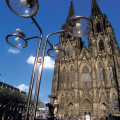COLOGNE CATHEDRAL
Gothic cathedral 157 meters high, with 533-step towers overlooking the city and the Rhine.
You can see it from almost anywhere in the city center and its outskirts: the magnificent Cologne Cathedral soars above the city. It is the pride of the people of Cologne and a UNESCO world heritage site. The cathedral's gigantic tower has dominated the city skyline since its completion in 1880. The cathedral is the second-tallest building in Cologne. It is 145 m long, with a transverse nave measuring 86 m. The cathedral's total surface area measures almost 8,000m2 and can accommodate over 20,000 people.
Construction. The foundation stone of the Gothic cathedral was laid on August 15, 1248, to mark the celebration of the Assumption of the Virgin Mary. The old cathedral was no longer large enough to house the mortal remains of the three Magi, which Archbishop Rainald von Dassel brought to the city from the conquest of Milan in 1164. These relics made the cathedral one of Europe's most important pilgrimage destinations. In the early 16th century, construction was halted, partly for lack of money, partly for lack of interest. By this stage, the choir, the lower part of the south tower with its bell tower, and the long nave and transverse aisle had been completed down to the lower arcades. The north tower was virtually non-existent. For over 300 years, the city's skyline was dominated by a huge construction crane near the still incomplete south tower. At the turn of the 19th century, supporters of the German Romantic movement reawakened public interest in completing the cathedral. The continuation, and completion, of the building was a matter of national interest for the Germans. In 1842, King Friedrich Wilhelm IV laid the foundation stone that marked the continuation of construction work. The cathedral was completed in 1880, according to the medieval plan, in a record time of just 38 years. Although badly damaged, Cologne Cathedral survived the bombardments of the Second World War. Today, the cathedral's greatest threats are weather and environmental influences.
The interior. The mass of stone seems to rise almost weightlessly to the 43-meter-high baldachin-style arches. The narrow main nave leading to the choir is accompanied by two side aisles. In the north side aisle, light shines through five spectacular glass bays from the final years of Cologne glass painting (1507-1509). In 2007, a completely new lighting concept was created in the cathedral's south nave by Cologne-based artist Gerhard Richter, in keeping with the codes of the medieval master builders.
At the far end is the main choir with the ambulatory choir, one of the most beautiful sanctuaries in the Western world. Its 104 stalls make it the largest in Germany. The choir paintings were added around 1340. Above, you'll see the older sculptures on the choir pillars of Jesus, Mary and the 12 apostles. In addition to the Adoration of the Magi, the full circle of windows on the upper level of the central nave depicts 48 additional royal figures. Behind the high altar, the shrine of the three kings rises. The relics of Gaspard, Melchior and Balthazar, the patron saints of the city of Cologne, rest here alongside the relics of Saints Felix and Nabor and St. Gregory of Spoleto. This impressive work of medieval gold craftsmanship surpasses all other shrines in the Western world in terms of size and grandeur. Gero's crucifix hangs in the chapel and is the largest remaining sculpture of Christ crucified this side of the Alps. The cathedral's oldest window (dating from around 1260) is still in its original position in the Axis Chapel (Chapel of the Three Kings). It shows scenes from the New and Old Testaments in two parallel rows. Another great work of art can be found in the choir of the Chapel of Mary. It's a triptych painted by Stefan Lochner for the town hall chapel, depicting the city's saints: the Three Holy Kings, St. Ursula and St. Gereon and their martyred companions.
The cathedral treasury. In the sacristan crypt, the cathedral treasury houses a rich collection of church treasures dating back to the 4th century. The treasure's works of art are made of gold, silver, bronze and ivory, and include holy relics, liturgical objects, textiles, archbishops' insignia, medieval sculptures and Franconian burials.
The south tower. The platform of Cologne Cathedral's south tower offers an impressive view from a height of around 100 m. To enjoy the view over the city and the Rhine, you must first climb the 533 steps. Weather permitting, you can see as far as the Siebengebirge hills. Climbing the steps takes visitors past the bell. Of the cathedral's eight bells, St. Peter's is the largest church bell in the world, weighing in at 24 tonnes.
There are several ways to discover the cathedral: from the forecourt, in daylight, you'll be struck by the dark, wide facade, whose towers truly look as if they're reaching for the sky. Or in the evening, when arriving in Cologne from the station. You'll see it haloed in green light.
Did you know? This review was written by our professional authors.
Book the Best Activities with Get Your Guide
Members' reviews on COLOGNE CATHEDRAL
The ratings and reviews below reflect the subjective opinions of members and not the opinion of The Little Witty.


Uma construção que muitos celebram pela vista que oferece do alto de sua torre. São mais de 500 degraus, mas a recompensa é uma vista de tirar o fôlego (ou será que o perdi na escadaria?).
Aqui está a mais antiga representação de Jesus crucificado, a Cruz de Gero, que tem capela própria.